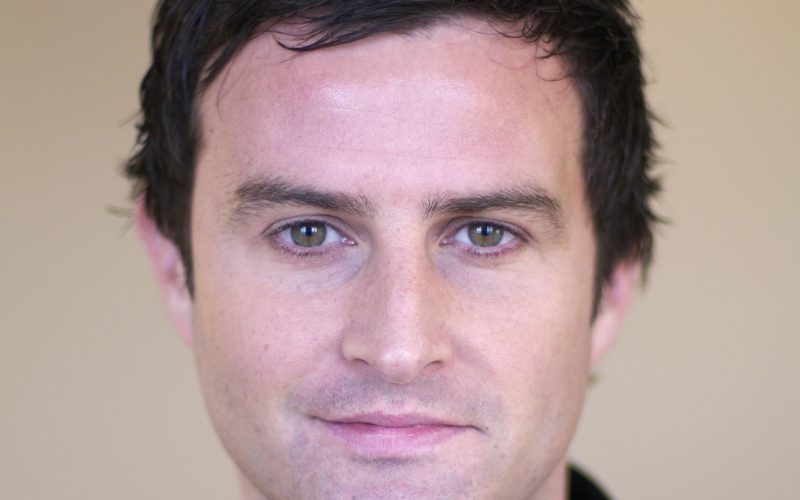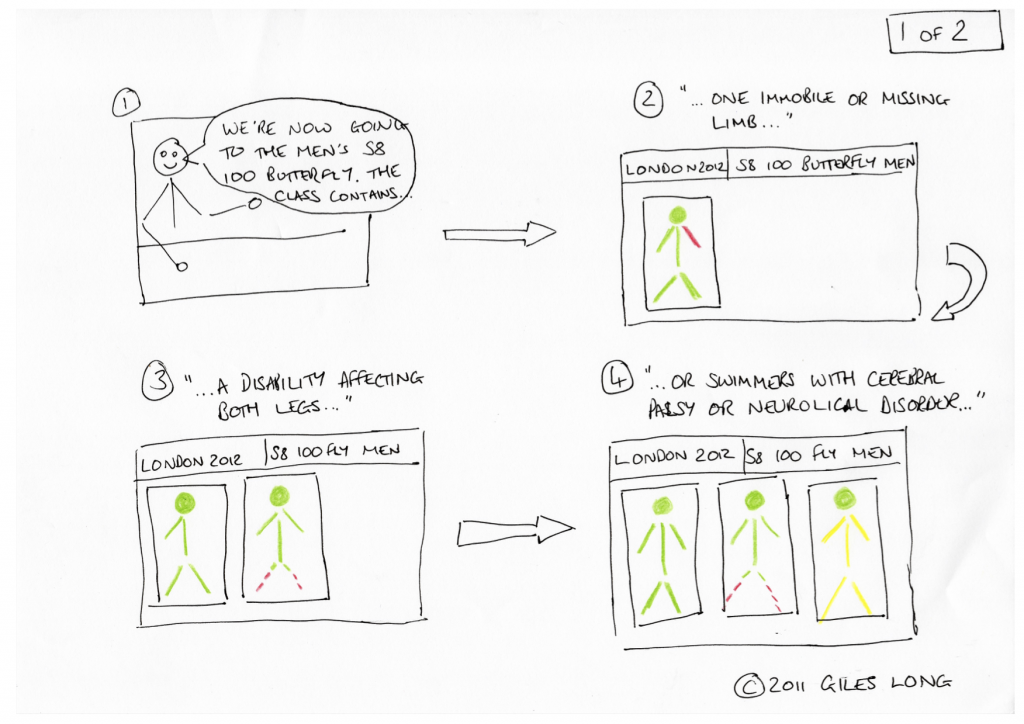
Last month we caught up with Giles Long MBE, triple Paralympic gold medallist, inventor of LEXI, the graphic system that explains Paralympic sports and CEO of Lexicon Decoder Productions.
At the age of thirteen Giles was diagnosed with cancer. He didn’t allow a bone tumour in his arm to put an end to his swimming career. Today Giles is one of the most successful Paralympic swimmers of our time.
Giles is the proud owner of a total of seven Paralympic medals, but when he first showed them to people, the confused expression on their faces revealed that they didn’t know how special the medals were, because they simply didn’t understand the parameters of Paralympic sport.
Confusion around disability in sport
The general public is confused by disability in sport. This is compounded by a fear of offending people, so they keep questions they are bursting to ask like, “Why is a guy with one arm racing with a guy with one leg?” and “How come their wheelchair is different to theirs?” to themselves.
After Giles came back from Sydney in 2000 he had the idea to answer those types of questions in the form of LEXI.

LEXI is a graphic that helps people understand why different impairment types are grouped together by using human icons to show affected areas of the body. In combination with approved narration scripting, it crucially shows how a disability affects an athlete in a sport-specific way. For example, a disability that impacts a runner will impact a skier in a different way, which is different again for swimming. In fact, it’s different for every single one of the 27 competitive Paralympic sports. No wonder the people watching are confused.
“My dad always says if you’ve got a lot to say in a short space of time then draw a picture”
Giles thought he was onto something, and told a few people in the broadcasting industry about LEXI, in the hope that it might be used to support the Paralympics in Athens in 2004, but he didn’t get anywhere. He tried again 4 years later for Beijing in 2008. No one was interested.
Giles believes that the lack of interest in LEXI wasn’t about the product itself, or the quality of the graphic or the concept. The biggest challenge was culturally what LEXI represented. LEXI is about talking about disability. Prior to London 2012, the Paralympics actively tried to avoid talking about disability. The Paralympics was about sport, only sport. If you look at the camera shots of the 1996 Paralympics in Barcelona they rarely even showed disability.
It wasn’t until London 2012 that the culture for addressing disability in sport began to shift. It all started when the London Organising Committee of the Olympic and Paralympic Games (LOCOG) decided for the first time to sell the broadcast rights to the Paralympics separately from the rights for the Olympics.
Channel 4 won the broadcast rights. As part of the bid for the rights, Channel 4 had committed to explaining about the classification of Paralympic sport to the watching public. And it just so happened that Giles was asked in conversation if he had any ideas about how they might do this
So, he drew LEXI with a biro on a pad for the team at Channel 4.

Finally a breakthrough
Finally, Giles had the breakthrough he needed and LEXI was piloted at the Paralympic World Cup in Manchester in 2011
It was then, with LEXI out in the public domain that Giles realised he needed to protect his idea. And he needed to do it quickly. He was advised to make sure that he had copyright on everything, at every stage of development and that he had this in writing.
“It made me pretty unpopular – people were rolling their eyes every time I mentioned copyright – thank God I did because I wouldn’t have a business now if not.”
After the Manchester Paralympic World Cup, the International Paralympic Committee (IPC) said LEXI needed improvement. David Abrahams, the now outgoing CEO Channel 4 said for LEXI to make the cut it needed to be redrawn to look “more sporty”. The Paralympics were drawing close and there was a heightened nervousness about the topic of disability combined with extra anxiety about being a host country under a lot of scrutiny.

The time pressure of the Paralympics may have served the launch of LEXI well. With an immovable deadline fast approaching, people were forced to adopt a looser approach that would allow Channel 4 to meet the commitment it had made in its pitch for the rights to the London Paralympic Games.
Meet the superhumans
The 2012 Paralympics on Channel 4 was phenomenal. The ‘meet the superhumans’ campaign tackled sport and disability head-on. It is still massively powerful today. Remind yourself here.
London 2012 Paralympics saw viewing figures like never before. Six million people watched Jonnie Peacock win the men’s 100 meters. Six million people saw LEXI.
A focus group following the games said 85% of the audience approved of LEXI. And no one was offended by talk of disability (the thing everyone was afraid of).
Giles thought that after London 2012 developing LEXI would become easier.
He was wrong.
Despite the world-class Paralympic campaign by Channel 4, outstanding viewing figures and massively positive imagery, it took about two weeks for the entrenched mind-set of “we talk sport, not disability” to re-establish itself. Even with all the stats and data to back it up, many people just reverted to type.
The battle to change mind-sets continues. Rio 2016 was again successful and LEXI was used in the USA, Canada, Japan and Australia, as well as the UK giving it a potential audience reach of 500 million people. It had moved from 2D to 3D animated characters and there is less text on screen (which is an important consideration in multiple languages with massive differences in text length). This is what LEXI looks like today.
The next challenge for Giles is to get LEXI into the Paralympic host feed coverage – the coverage that the host country produces from which all other countries take their sports pictures from.
Giles will keep pushing LEXI because he is passionate about the Paralympics and knows first-hand that what athletes’ want is to have their story told to the world, a story partly of sporting performance, partly of disability but also of hopes, dreams and aspiration that anyone can have, regardless of their gender, sexuality or ability. Watch this space.
Making an idea happen
No idea operates in isolation; there were a series of things that lined up in the story of LEXI; the idea in Giles’ head, Channel 4 winning the broadcast rights and committing to a massive cultural shift to explain disability in sport.
Giles’ advice to anyone who is nursing an idea or an innovation is…
- You have to care about it. If you don’t, how can you expect others to?
- An idea is of its time, you might have a really good idea but if external forces are not aligned it won’t work. You have to bide your time and strike when the time is right.
- If your idea is ahead of its time, keep it on the back burner and every so often have another go at telling people. Don’t give up.
- Remember the most valuable thing you have is your ideas. Involve others in shaping them and at the same time protect your idea. Be diligent on paperwork and seek legal advice on IP and copyright.
- Lots of people will be sceptical, having a new idea that is unfamiliar to people means you have work to do to develop your strategy in how you convince others about the value of your idea.
- Unless you have deep pockets you’re unlikely to be able to take someone to court. Remember the power of negative PR and don’t be afraid to leverage this to stand up for your rights through your social media networks.
- From the outset, if it’s an idea that you want to be big – treat it like it is big already.
- Help people understand your idea by shining a light on what happens if change doesn’t happen.
- Break entrenched opinions by breaking patterns, Giles used to interrupt with things like “I’m a triple Paralympic gold medallist I know what I’m talking about” to shift the dynamic in a repetitive or stuck conversation.
If you’d like to learn more insights from other successful innovators check out the new Innovation Leadership Launchpad – a mix of case stories and practical tips to help you innovate. Order your free copy straight into your inbox today.
